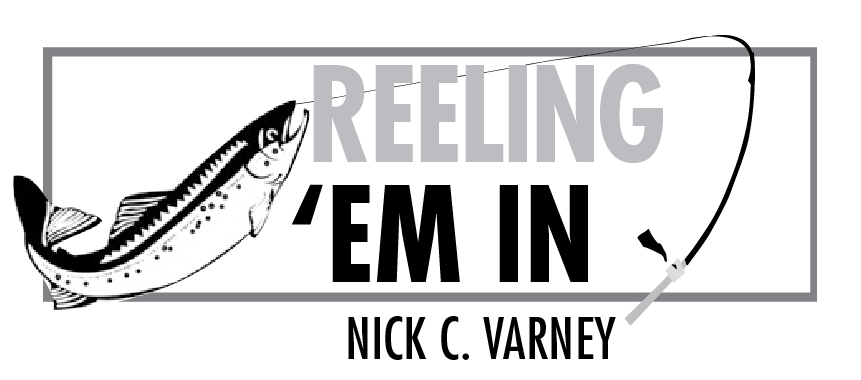Now that we are beginning the slow tumble into the deep fall season where land hunts rule, don’t forget the stunning silvers and steelhead swaggering into some of the streams.
The attitudes of these gleaming finned missiles have a tendency to morph into ravenous pack-stalker mindsets around the crack of dawn and the pre-snap of night so you might want to give them a shot instead of blowing up a duck.
As mentioned in previous columns, coho are spooky and avoid daylight like it’s a cannon balling skinny dipper the size of a mature beluga.
They have a thing for rain and tend to scoot upstream as the water level rises and turns as cool as you think you are strutting around in gear that costs more than a maxed out iPad Pro.
Some anglers prefer to spin cast for coho and the shrewd ones don’t stop their retrieve until the lure is near enough to nearly plant a hook into the boot of their waders.
Why? Silvers will often follow a lure all the way in before striking.
Trust me. If you ever get slammed just before taking the spinner out of the water, two things will likely occur.
First, you’ll probably lose the fish because you’ll be so startled that you’ll monkey dance backwards like you’ve been attacked by a mako or assume the classic clueless dweeb freeze and never set the hook.
Second, if it was a huge fish, you’ll wish that part of your layered clothing had included a pair of Depends.
One more suggestion: While retrieving the line, move the rod to the left or right once in a while to change the direction of the lure. Also just stop reeling altogether for a second allowing the lure to flutter to see if that cajoles a strike.
If you want to give fly fishing a shot while aiming for fish holding in the slower currents, don’t cast on top of them. Throw above or to side of where the fish are concentrated then initiate your retrieve as short strips with an occasional pause.
Coho are selfish suckers and will abandon their school buddies to chase and hit a fly. Once hooked, they’ll cop a nasty attitude and will usually blast out of the water with a tendency to roll in the line and leader like a 100 proof infused next of kin taking a stab at anchoring his side of a family reunion tug-of-war.
One other thing, steelhead are lurking out there. They are true warriors and will put up one hell of fight so show respect when you release them.
Since this is my last fishing column for the year I’d like to leave you with a few end-of-season reminders.
The flowing waters of the Anchor River, Ninilchik River, Deep Creek and Stariski Creek are restricted to one unbaited, single-hook through Oct. 31.
Salmon may not be targeted or harvested upstream of the two-mile regulatory markers on the Anchor River, Ninilchik River, Deep Creek or Stariski Creek.
Saltwater Fisheries
Halibut fishing is still possible throughout the fall and into the winter. If the weather allows, check out the kelp beds.
Feeder kings will be skulking year round in Kachemak Bay. Their general loitering sites include: Point Pogibshi, Bluff Point, the islands around Eldred Passage, Bear Cove and various other super secret locations on the south side of Kachemak Bay.
Fall and winter storms tend to limit lingcod fishing substantially unless you’re nuts. Try the waters near the Barren and Chugach islands.
Lingcod season is open through Dec. 31, and the bag and possession limit is two fish with a minimum legal size of 35 inches.
You can try your luck off the end of the Homer Spit during winter for a multiplicity of finned critters some of which are even edible and no threat to small pets wandering the beach.
Freshwater Fisheries
Fall fishing success on the Homer area streams will fluctuate with changing water conditions associated with periods of rain.
The steelhead runs typically peak in mid to late September.
Dolly Varden will continue to be available through ice-up and are a flat hoot on light tackle.
Shellfish
All Eastside Cook Inlet beaches from the Kenai River to the tip of the Homer Spit are closed to all clams and mussels through Dec. 31.
The Cook Inlet and North Gulf Coast sport, personal use and subsistence Tanner crab fisheries will not open for the 2015-2016 season.
So … the time has come to put this column into hibernation for another seven months or so.
I want to express my deep appreciation to all of you who have read, supported and emailed the column during the season. Your tips, tales and expertise have been invaluable and even tear-inducing hilarious.
A special tip of my bait spattered cap to Lou, Tom, Gary, Jack, Kristen, Stanley, Ryan and Rudy who helped make my summer.
And finally, I want to give a special shout-out to our local Alaska Fish and Game crew, especially Joey. Thank you for your patience, sense of humor and the priceless information that you’ve provided each week.
So long until the kings come home.
Nick can be reached at ncvarney@gmail.com.


